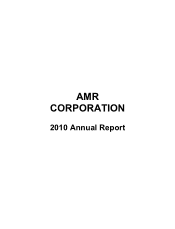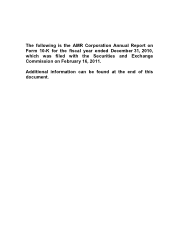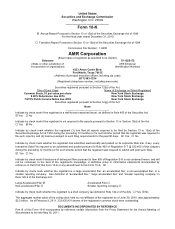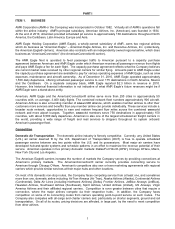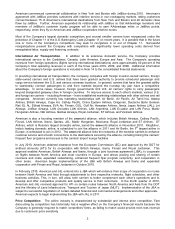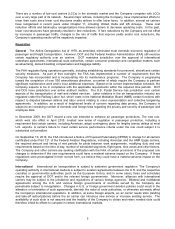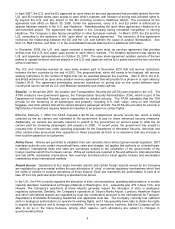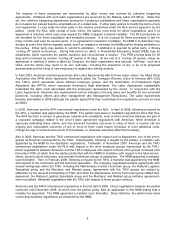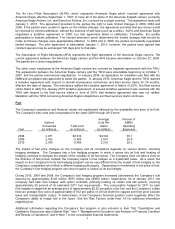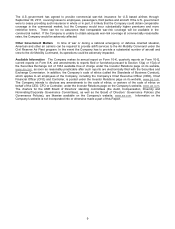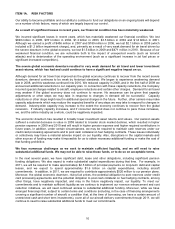American Airlines 2010 Annual Report Download - page 4
Download and view the complete annual report
Please find page 4 of the 2010 American Airlines annual report below. You can navigate through the pages in the report by either clicking on the pages listed below, or by using the keyword search tool below to find specific information within the annual report.
1
PART I
ITEM 1. BUSINESS
AMR Corporation (AMR or the Company) was incorporated in October 1982. Virtually all of AMR’s operations fall
within the airline industry. AMR's principal subsidiary, American Airlines, Inc. (American), was founded in 1934.
At the end of 2010, American provided scheduled jet service to approximately 160 destinations throughout North
America, the Caribbean, Latin America, Europe and Asia.
AMR Eagle Holding Corporation (AMR Eagle), a wholly-owned subsidiary of AMR, owns two regional airlines
which do business as "American Eagle” – American Eagle Airlines, Inc. and Executive Airlines, Inc. (collectively,
the American Eagle® carriers). American also contracts with an independently owned regional airline, which does
business as “AmericanConnection” (the AmericanConnection® carrier).
The AMR Eagle fleet is operated to feed passenger traffic to American pursuant to a capacity purchase
agreement between American and AMR Eagle under which American receives all passenger revenue from flights
and pays AMR Eagle a fee for each flight. The capacity purchase agreement reflects what the Company believes
are current market rates received by other regional carriers for similar flying. Amounts paid to AMR Eagle under
the capacity purchase agreement are available to pay for various operating expenses of AMR Eagle, such as crew
expenses, maintenance and aircraft ownership. As of December 31, 2010, AMR Eagle operated approximately
1,500 daily departures, offering scheduled passenger service to over 175 destinations in North America, Mexico
and the Caribbean. On a separate company basis, AMR Eagle reported $2.3 billion in revenue in 2010.
However, this historical financial information is not indicative of what AMR Eagle’s future revenues might be if
AMR Eagle were a stand-alone entity.
American, AMR Eagle and the AmericanConnection® airline serve more than 250 cities in approximately 50
countries with, on average, 3,400 daily flights. The combined network fleet numbers approximately 900 aircraft.
American Airlines is also a founding member of oneworld® alliance, which enables member airlines to offer their
customers more services and benefits than any member airline can provide individually. These services include a
broader route network, opportunities to earn and redeem frequent flyer miles across the combined oneworld
network and more airport lounges. Together, oneworld members serve 750 destinations in approximately 150
countries, with about 8,500 daily departures. American is also one of the largest scheduled air freight carriers in
the world, providing a wide range of freight and mail services to shippers throughout its system onboard
American’s passenger fleet.
Competition
Domestic Air Transportation The domestic airline industry is fiercely competitive. Currently, any United States
(U.S.) air carrier deemed fit by the U.S. Department of Transportation (DOT) is free to operate scheduled
passenger service between any two points within the U.S. and its possessions. Most major air carriers have
developed hub-and-spoke systems and schedule patterns in an effort to maximize the revenue potential of their
service. American operates in five primary domestic markets: Dallas/Fort Worth (DFW), Chicago O'Hare, Miami,
New York City and Los Angeles.
The American Eagle® carriers increase the number of markets the Company serves by providing connections at
American’s primary markets. The AmericanConnection® carrier currently provides connecting service to
American through Chicago O’Hare. American's competitors also own or have marketing agreements with regional
carriers which provide similar services at their major hubs and other locations.
On most of its domestic non-stop routes, the Company faces competing service from at least one, and sometimes
more than one, domestic airline including: AirTran Airways (Air Tran), Alaska Airlines (Alaska), Continental Airlines
(Continental), Delta Air Lines (including Northwest Airlines) (Delta), Frontier Airlines, JetBlue Airways (JetBlue),
Hawaiian Airlines, Southwest Airlines (Southwest), Spirit Airlines, United Airlines (United), US Airways, Virgin
America Airlines and their affiliated regional carriers. Competition is even greater between cities that require a
connection, where the major airlines compete via their respective hubs. In addition, the Company faces
competition on some of its connecting routes from carriers operating point-to-point service on such routes. The
Company also competes with all-cargo and charter carriers and, particularly on shorter segments, ground and rail
transportation. On all of its routes, pricing decisions are affected, in large part, by the need to meet competition
from other airlines.

